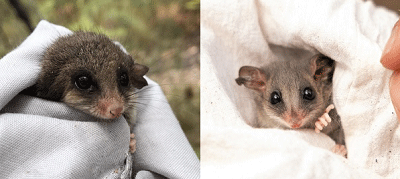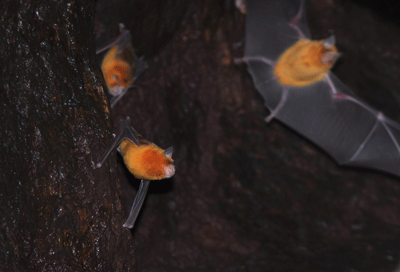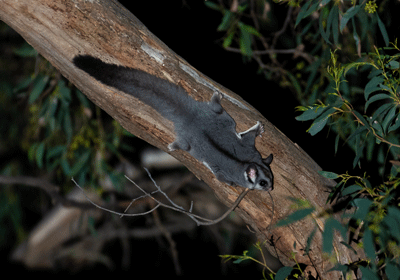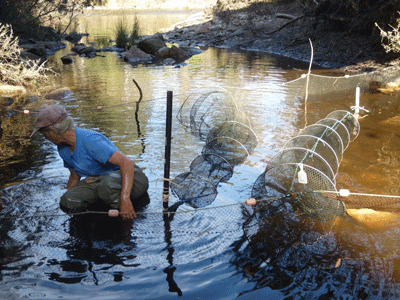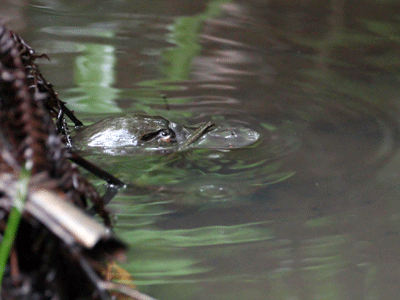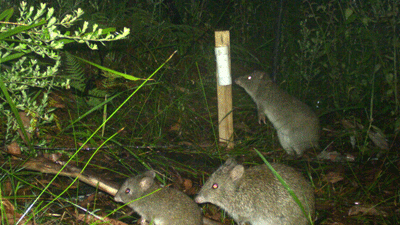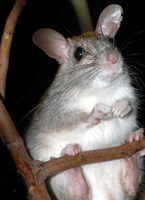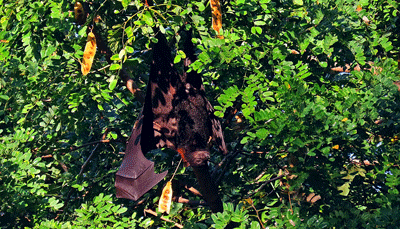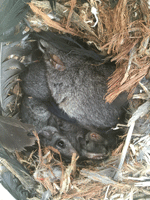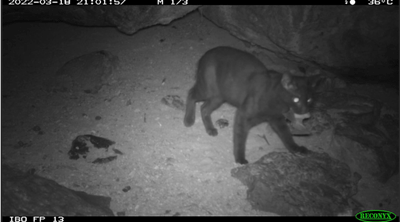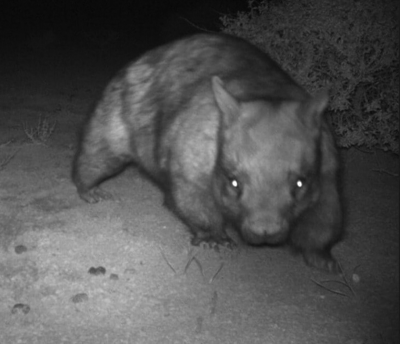In this paper we discuss how to recognise ‘Top End’ bats from their echolocation sequences, data needed for rapid inexpensive survey and monitoring programmes that inform conservation planning. We present the results of the first systematic survey of the bats occupying Northern Territory mangrove forests. More broadly, we identify environmental controls influencing the species composition and structure of tropical bat communities across north-western Australia.
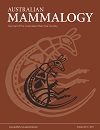
Australian Mammalogy
Volume 46 Number 3 2024
AM24011Eastern pygmy possum (Cercartetus nanus) populations persist in Central Coast forests after the Black Summer bushfires
The Black Summer bushfires were catastrophic, impacting some of Australia’s most iconic species. This study used pre- and post-fire data to determine how the bushfires affected eastern pygmy possum populations on the NSW Central Coast, finding that some populations were able to persist. This study helps improve our understanding of the susceptibility of native species to such events, which becomes increasingly important as wildfires are predicted to increase in frequency and intensity in response to climate change. Left photograph by Dylan Chew; right photograph by Brad Leue, AWC.
AM23055A long-distance flight of the Pilbara diamond-faced bat (Rhinonicteris aurantia) recorded via an automated VHF radio telemetry system
Understanding movement patterns of threatened bats is critical, though sometimes difficult, to conserving their habitats. This study was undertaken to understand movement patterns for the threatened Pilbara diamond-faced bat, resulting in the recordings of two large, 40-km, flights undertaken over single nights. This study will be used to conserve habitat for the species and demonstrates the capability of new and emerging tracking technology. Photograph by Christopher Knuckey.
The red-tailed phascogale is a threatened marsupial species native to Australia, and it has been reintroduced to Mt Gibson Wildlife Sanctuary in Western Australia. Traditional monitoring methods for the species did not work at Mt Gibson, so we relied on camera monitoring until we developed an arboreal trapping method. The monitoring methods have shown that the reintroduction has been successful, and the arboreal trapping methods may be useful at other red-tailed phascogale populations.
Understanding glide performance in gliding mammals provides useful knowledge. We investigated this in the inland sugar glider (Petaurus notatus) in central Victoria. From 40 glides, horizontal glide distance averaged 18.1 m (range 8–41 m), glide ratio (horizontal glide distance/height dropped) averaged 2.2 and glide angle averaged 26.4°. Photograph by William Terry
Bandicoots and bilbies are among the most threatened Australian mammals, but their general behaviour is poorly studied. We studied exploratory behaviour of adult male northern brown bandicoots (Isoodon macrourus), finding inter-individual variation in exploration over time. Older bandicoots that appeared to be in better breeding condition were also less exploratory, indicating a possible life-history trade-off between reproduction and maintenance. Our pilot study on bandicoot exploratory behaviour could provide insights on their potential dispersal ability and movements in their natural landscapes.
AM24026Platypus fyke-netting methods: a review of recommended field protocols and options for assessing population abundance
Fyke nets are commonly used for platypus survey or other research purposes in shallow water bodies. We discuss the wide range of factors influencing the frequency of platypus captures, identify issues affecting animal welfare in fyke nets and consider the options available for estimating platypus abundance from fyke-netting data. Photograph by G. Williams/APC.
This article belongs to the collection: Recent research on the platypus.
AM24026 Abstract | AM24026 Full Text | AM24026PDF (2.5 MB) Open Access Article
Wombats commonly come into care due to collisions with vehicles, sarcoptic mange and attacks. Caring for wombats is time-consuming and expensive, particularly when raising wombat joeys, which were more likely to be successfully rehabilitated and released compared to adult wombats. This paper provides insights into the issues facing wombats, the people that care for wombats, and the wider carer sector.
Animals modify their behaviour to avoid poor conditions like temperature extremes, which affects the success of observation studies. We surveyed greater bilbies (Macrotis lagotis) at least once a year between 2015 and 2023 and found that as average environmental temperature decreased, the number of bilby observations also decreased within a spotlight survey session. Wildlife managers should include environmental temperature as a factor in survey timing and analysis.
Sperm storage is common in dasyurid species and has been recorded for up to 8 days in red-tailed phascogales (Phascogale calura). We present a case where sperm storage has occurred for 15–27 days in a free-living translocated red-tailed phascogale. Our result is the longest sperm storage period recorded to-date in dasyurid species.
AM24020Age determination in the platypus (Ornithorhynchus anatinus) using spur sheath and spur developmental stages: a review
Male platypuses have a permanent venomous spur on both rear ankles. Their structure changes with age, while females only develop a small rudimentary spur sheath that is lost after their first year of life. Spur or spur sheath changes are used to age males in their first 3 years of life. Females can only be aged in their first 2 years. This age determination is used to age dead or living platypuses in research, veterinary or rescue contexts. Photograph credit: Ian Montgomery
AM24020 Abstract | AM24020 Full Text | AM24020PDF (3.5 MB) Open Access Article
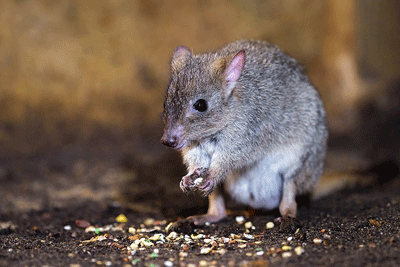
IMAGE: Woylie in Zoo Praha: Petr Hamernik, Wikimedia commons. https://commons.wikimedia.org/wiki/File:Klokánek_králíkovitý_zoo_praha_1.jpg.
Bettongs and potoroos are important for maintaining biodiversity, but we do not know much about how difficult their foods are to eat in the wild. We measured the toughness and stiffness of their foods, including roots and tubers, fruit, fungi, invertebrates, seeds, and leaves, and compared these with farmed items from similar food groups. This information is important for understanding how these animals survive in the wild and for designing diets for them in captivity.
AM24006 Abstract | AM24006 Full Text | AM24006PDF (1 MB) Open Access Article
The northern quoll is a small, endangered marsupial that inhabits the northern areas of Australia, including overlapping with areas targeted for mining in the Pilbara. Following more than 10 years of long-term data collection in the Pilbara, we present best practice survey techniques and options for reducing the impact of disturbance or improving northern quoll populations. These survey techniques are relevant to northern quoll research, conservation management, to detect their presence in areas previously unsurveyed, and for monitoring the outcomes of management activities.
Camera trapping was used to describe aspects of the breeding pattern in the long-nosed potoroo in the north of its range. Cameras operated continuously at eight sites over a 17-month period. Females produced two to four young per site equating to 2.1 per year. Image by R. Goldingay.
AM24007The golden-backed tree-rat (Mesembriomys macrurus) (Peters 1876): reproduction, growth, development and behaviour in captivity
The golden-backed tree-rat, a large native rodent from tropical Western Australia and Northern Territory, was once abundant and widespread, but numbers have declined greatly. Its conservation depends on knowing its ecology and breeding biology, and in this study we provide the first details of the breeding biology of this tree-rat. This information is essential for developing conservation strategies to ensure the survival of this unique Australian species. Photograph by Euan Ritchie.
Roosting ecology in Australia’s flying-fox species is characteristically colonial, though a small amount of scientific literature refers to solitary roosting individuals or singletons. This note reports five accounts of black and grey-headed flying-foxes roosting as singletons outside of periods of food shortages, including one instance of solitary roosting occurring over multiple days. Photograph by Matthew Mo.
Boodies (burrowing bettongs, Bettongia lesueur) have a maternal social structure in their remnant natural population on Barrow Island. We have successfully recreated a similar social structure in Matuwa Kurrara Kurrara National Park, despite translocation and hybridisation. Given that many attempts to translocate boodies to the unfenced landscape have failed, possibly because the translocated animals showed no site fidelity or group cohesion, our research is the first to recommend that pre-existing social groups be translocated together, rather than random individuals.
AM23049_COCorrigendum to: Feral cat predation of the threatened Pilbara leaf-nosed bat – a key threatening process
Artificial tree cavities may be installed to restore habitat quality for tree-cavity-dependent wildlife. We used detections of the brush-tailed phascogale (Phascogale tapoatafa) and the inland sugar glider (Petaurus notatus) in nest boxes over a 6-year period to investigate the influence of the surrounding forest on nest box use. Image: R. Goldingay
The greater bilby, an iconic and culturally important Australian marsupial, now inhabits less than 20% of its former range. The Pilbara bioregion, a vast multi-use landscape in the north-west of Western Australia (WA) is an important stronghold for the species. To improve knowledge of the status and ecology of bilbies in northern WA, a research program, informed by multiple stakeholders, was instigated. The ensuing program has greatly enhanced our ecological knowledge of the bilby in the Pilbara and elsewhere in WA. Photograph by © John Lawson.
AM24002 Abstract | AM24002 Full Text | AM24002PDF (1.2 MB) Open Access Article
Cat predation is recognised as a significant threat to Australian wildlife. We consolidated evidence of feral cat predation on a threatened bat species (Pilbara leaf-nosed bat (Rhinonicteris aurantia) in the Pilbara region of Western Australia, demonstrating repeated predation of R. aurantia by several individual cats at three significant bat roosts. We provide evidence supporting the recognition of feral cat predation as a key threat to this species and recommend the threat be managed proactively using multiple established and emerging methods. Camera trap image provided by Jessie Moyses.
AM23049 Abstract | AM23049 Full Text | AM23049PDF (1.6 MB) | AM23049Corrigendum (683 KB) | AM23049Supplementary Material (421 KB) Open Access Article
AM24027Digging for answers: defining the external architecture of the southern hairy-nosed wombats’ (Lasiorhinus latifrons) subterranean excavations
The burrow excavated by the southern hairy-nosed wombat is initially located by an entrance into the ground, but entrances also lead to other structures, with these not previously defined. With counts of active burrows used as the primary feature in population estimations, accuracy in their identification is vital. Here, we provide definition of these structures to increase the accuracy of population estimations but also to increase knowledge of the southern hairy-nosed wombat’s digging activity, functional potential, warren system architecture, and possible adaptive ability. Image by R. Norris.



